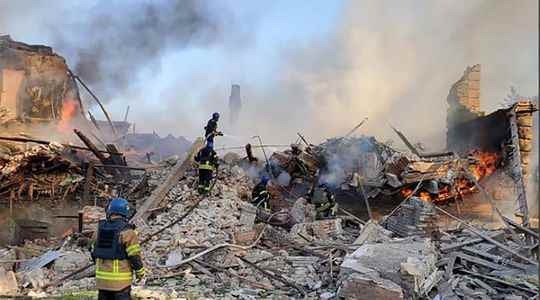On February 24, the troops of the Russian army entered Ukraine to carry out a military offensive which was supposed to be lightning. Three months later, while entire towns are now destroyed, the fighting is still raging. After repelling the invader from the two major cities of kyiv and Kharkiv, the Ukrainian resistance is committed to repelling Moscow’s massive offensive in the Lugansk region, in the Donbass. The president of the invaded country, Volodymyr Zelensky calls for new Western military aid to break the impasse.
- An “extremely difficult” situation in the Donbass
The situation is even “extremely difficult”, admitted Volodymyr Zelensky, during a televised address on Monday evening. “The Russian occupiers are trying to show that they will not abandon the occupied areas. (…) They are advancing somewhere. They are strengthening their positions elsewhere,” he said. The Ukrainian redoubt in the Lugansk region now concentrates all the attention of Moscow, which hopes to encircle the cities of Severodonetsk and Lyssytchansk. Bombs are raining down on eastern Ukraine. Fighting is ongoing in the localities of Popasna and Bakhmout, which clearly indicates the Russian intention to surround the region. The Russian invasion seeks to “eliminate all that is alive”, accused President Zelensky.
Despite the risks, many people do not want to flee the combat zones. This is the case in Bakhmout, in the oblast of Donetsk, a city prized by the Russians in order to encircle the Ukrainian command center to coordinate the war effort. “People don’t want to leave,” lamented deputy mayor Maxim Soutkovyï. Faced with the firepower of his adversary, the local authorities took the decision to reinforce evacuations. “We have reached a point where we are in the process of making evacuations compulsory,” said the head of the military administration of Bakhmout, Serguiï Kalian. But the inhabitants are reluctant to flee. The next days of war could bring heavy civilian casualties.
- Twenty countries coordinate for new military aid
Faced with increasing Russian pressure, kyiv is calling on the international community for new arms donations. A call to which the West is responding since twenty countries have pledged to provide additional weapons to Ukraine while strengthening resistance training, announced US Secretary of Defense Lloyd Austin. Among the most awaited equipment in the ranks of the army, there is notably the Harpoon anti-ship missile launcher system. Promised by Denmark, it can hit a target at sea or on land within a radius of 125 to 300 kilometers.
This sophisticated system, equipped with an autonomous radar, could allow Ukraine to counter the blockade imposed by the Russian navy on the port of Odessa. A way for the uncommitted powers to re-enable the country’s wheat exports, vital to the food systems of many nations. Ammunition for artillery, coastal defense systems, tanks and other armor should also be delivered as part of this coordinated response decided on Monday. Weapons demanded by the Ukrainian army through the voice of its president at the World Economic Forum in Davos: “Ukraine needs all the weapons we ask for, not just those that have been provided…
- Three months of war, what human toll?
There are very few precise figures to quantify the extent of human losses in Ukraine since the beginning of the war. The main bodies monitoring the progress of the conflict and the official Ukrainian and Russian bodies agree that several thousand people, civilians and soldiers, perished in the conflict. In the city of Mariupol, epicenter of the fighting for several months, the authorities announce the death of 20,000 civilians.
In the military ranks, the Ukrainian Ministry of Defense estimates Russian losses at nearly 30,000 men since February 24 and the first day of war. Western sources mention some 12,000 Russian soldiers killed. The authorities concede “significant losses”. More than a month ago, Volodymyr Zelensky spoke of around 2,500 to 3,000 Ukrainian soldiers had been killed, a figure very likely to be understated.
More than eight million Ukrainians have been internally displaced, according to the International Organization for Migration (IOM) and the UN High Commissioner for Refugees (UNHCR). More than six million have fled abroad.
- Russian oil: optimism around a European embargo
A European embargo on Russian oil is possible “within a few days”, estimated the German Minister of Economy Robert Habeck, while the subject does not currently have the necessary unanimity within the Twenty-Seven . “There are only a few states left, especially Hungary, which have reported problems,” Robert Habeck assured ZDF public television on Monday evening. But “discussions are continuing” and “I think we will achieve a breakthrough in a few days.”
The Europeans have already announced the end of Russian coal imports from next August. But an oil embargo by the end of the year is still under discussion. Originally, Brussels planned to stop imports of Russian crude oil within six months and refined products by the end of 2022.
